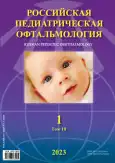Clinical features of internal fistula obliteration after trabeculectomy in congenital glaucoma and the possibility of laser treatment
- Authors: Arestova N.N.1,2, Panova A.Y.1, Kireeva S.A.1
-
Affiliations:
- Helmholtz National Medical Research Center of Eye Diseases
- A.I. Evdokimov Moscow State University of Medicine and Dentistry
- Issue: Vol 18, No 1 (2023)
- Pages: 5-12
- Section: Original study article
- URL: https://journal-vniispk.ru/1993-1859/article/view/131777
- DOI: https://doi.org/10.17816/rpoj321432
- ID: 131777
Cite item
Abstract
AIM: This study aimed to evaluate the clinical features of internal fistula obliteration after trabeculectomy (TE) in children with congenital glaucoma and the possibility of laser treatment.
MATERIAL AND METHODS: The study included 73 eyes of 56 children with congenital glaucoma who underwent TE between 3 months and 16 years. Yttrium aluminum garnet (YAG) laser refistulization was performed postoperatively because gonioscopy results revealed a complete or partial block of the internal fistula. In addition, a patented technique was utilized that combines the use of defocused and focused YAG laser radiation.
RESULTS: The internal fistula was more often blocked by the iris root. YAG laser refistulization eliminated the block in 97.3% of cases, and in two cases, planar splices that had existed for >6 months could not be dissected. Laser removal of the internal fistula block in 97.3% of cases led to a normalization of the intraocular pressure (IOP) immediately after surgery and in 80.7% of cases in the subsequent year. Early refistulization (up to 3 months after TE) reduced the risk of IOP decompensation by 2.6 times by the annual follow-up.
CONCLUSION: In children with congenital glaucoma, internal fistula obliteration (both complete and partial) by the iris root, iridotrabecular or iridocorneal contact, fusion, or pigment may occur at the earliest stages after TE, which is an indication of laser refistulization. When the internal fistula is overgrown after TE in children with congenital glaucoma, YAG laser refistulization allows restoring the lumen of the internal fistula in 97.3% of cases. Therefore, for timely detection and elimination of the blockade, gonioscopic monitoring of the internal fistula is necessary both at the earliest possible time and in the long term after TE.
Full Text
##article.viewOnOriginalSite##About the authors
Nataliya N. Arestova
Helmholtz National Medical Research Center of Eye Diseases; A.I. Evdokimov Moscow State University of Medicine and Dentistry
Author for correspondence.
Email: arestovann@gmail.com
ORCID iD: 0000-0002-8938-2943
SPIN-code: 4875-6288
MD, Dr. Sci. (Med.)
Russian Federation, Moscow; MoscowAnna Yu. Panova
Helmholtz National Medical Research Center of Eye Diseases
Email: annie_panova18@mail.ru
ORCID iD: 0000-0003-2103-1570
SPIN-code: 9930-4813
MD, Cand. Sci. (Med.)
Russian Federation, MoscowSofia A. Kireeva
Helmholtz National Medical Research Center of Eye Diseases
Email: 19sofia199611@gmail.com
ORCID iD: 0009-0000-4623-9664
MD, doctor
Russian Federation, MoscowReferences
- Papadopoulos M, Edmunds B, Chiang M, et al. Glaucoma Surgery in Children. In: Weinreb R.N., Grajewski A., Papadopoulos M., Grigg J., Freedman S. (eds) Childhood Glaucoma. WGA Consensus Series – 9. Kugler Publications: Amsterdam, 2013:95–134.
- Khan AO. A Surgical Approach to Pediatric Glaucoma. The Open Ophthalm. J., 2015,9:104–112.
- Scuderi G, Iacovello D, Pranno F, et al. Pediatric Glaucoma: A Literature’s Review and Analysis of Surgical Results. Hindawi Publishing Corporation BioMed Research Intern. 2015, Article ID 393670, 8 pages. //dx.doi.org/10.1155/2015/393670
- Kulkarni SV, Damji KF, Fournier AV, et al. Endoscopic goniotomy: early clinical experience in congenital glaucoma. J. Glaucoma. 2010; 19:264–269.
- Dao JB, Sarkisian SRJr, Freedman SF. Illuminated microcatheter-facilitated360-degree trabeculotomy for refractory aphakic and juvenile open-angle glaucoma. J. of Glaucoma. 2014;23(7): 449–454.
- Lazareva AK, Kuleshova ON, Ajdagulova SV, Chernyh VV. Features of pediatric glaucoma: review. Nacionalniy J. Glaucoma. 2019;18(2):102–112 (in Russ).
- Arestov DO. Surgical aspects of ultrasound trabeculectomy in the treatment of congenital glaucoma in children. Russian Pediatric Ophthalmology. 2014;1:5–11. (in Russ).
- Kuleshova ON, Nepomnyashchikh GI, Aidagulova SV. Analysis of morphological changes of yukstacanalicular tissue and sclera on operating material in primary juvenile and open-angle glaucoma. Oftalmohirurgiya. 2008; 3:12–15. (In Russ.).
- Terraciano AJ, Sidoti PA. Management of refractory glaucoma in childhood. Curr Opin Ophthalmol. 2002;13(2):97–102. doi: 10.1097/ 00055735-200204000-00008
- Tanimoto SA, Brandt JD. Options in pediatric glaucoma after angle surgery has failed. Curr Opin Ophthalmol. 2006;17(2):132–137. doi: 10.1097/01.icu.0000193091.60185.27
- Tung I, Marcus I, Thiamthat W, Freedman SF. Second glaucoma drainage devices in refractory pediatric glaucoma: failure by fibrovas-cular ingrowth. Am J Ophthalmol. 2014;158:113–117. doi: 10.1016/j. Ajo.2014.03.017
- Patent No. 2633342 C1 Russian Federation, IPC A61F9/007; A61F9/008 Method of IAG-laser refistulization during blockade of the internal fistula after trabeculectomy in children with postuveal glaucoma: No.2016149417: application 15.12.2016: publ. 11.10.2017/ Katargina L.A., Arestova N.N., Denisova E.V., Egiyan N.S., Ibeid B.N.A.
- Katargina LA, Arestova NN, Denisova EV, Ibeid BNA. YAG-laser refistulation of internal fistula after sinustrabeculectomy in children with postuveal glaucoma. Oftalmohirurgiya, 2019;1:57–61. (in Russ.). doi: 10.25276/0235-4160-2019-1-57-61
Supplementary files














